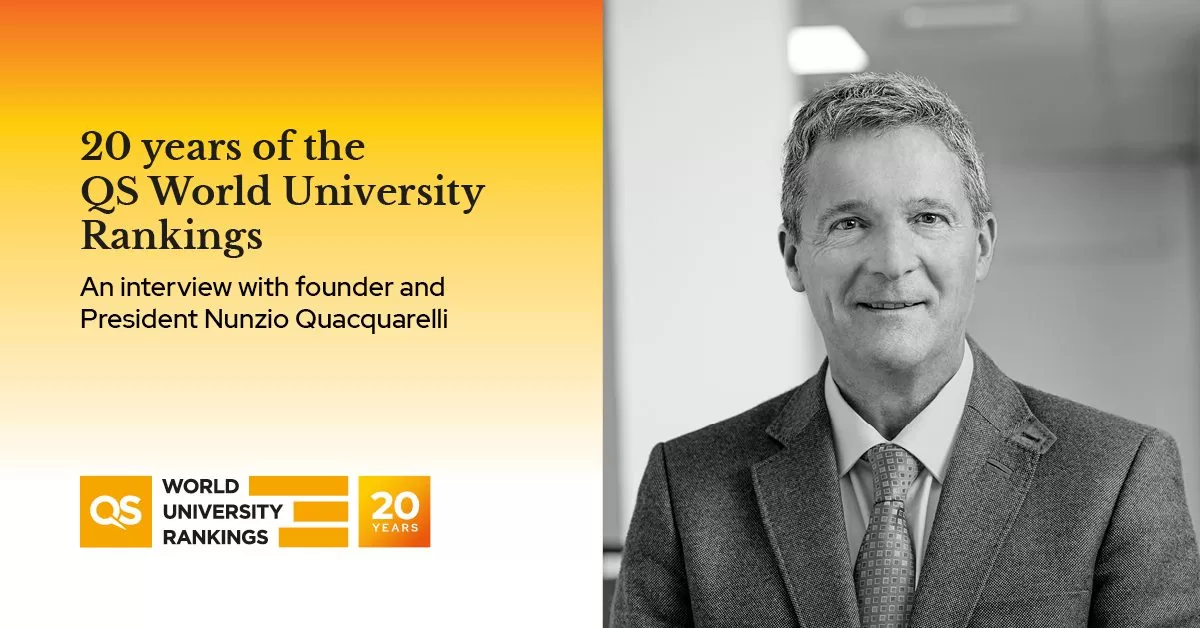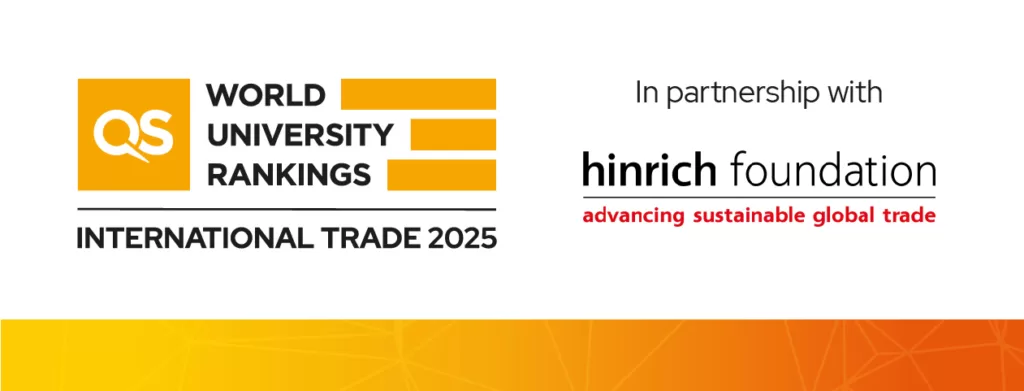
On 27 June 2023, we’ll launch the 20th edition of our flagship QS World University Rankings.
It’s a day which marks 20 years of QS working in partnership with the sector to build and evolve a robust methodology which reliably reflects the performance of universities across the globe.
We spoke to QS founder and President Nunzio Quacquarelli about the origins of the rankings and his reflections on what preparing to launch the 20th edition means to him personally.
The origins of the QS World University Rankings
Having graduated with a bachelor’s degree in economics from the University of Cambridge, Nunzio worked in consulting for several years before he decided to study an MBA.
“During the process of researching where to study my MBA, I found that there was no data or information to compare business schools or universities,” he explained, “I had to rely on word-of-mouth recommendations from partners at the consulting firm where I was working.”
He chose to study at the Wharton School at the University of Pennsylvania, which is where QS began – initially as a student project – to “fill that information void” and give international students access to comparative data and information about business schools.
“While still at the Wharton School, I started QS as a mission-led business. 33 years later we still have the same mission we had in 1990, to enable motivated people anywhere in the world to fulfil their potential through educational achievement, international mobility and career development. I’m very passionate about our mission and everything we do at QS revolves around it.”
In those early days, QS produced global employer surveys to provide insights into the demand for MBAs and the skills needed among graduate students.
Thanks to a growing reputation for expertise and reliable data collection in graduate management education, Nunzio was approached by the Financial Times in 1994 to collaborate on a business school ranking.
“I declined the invitation at that time because I felt that a ranking could be controversial and potentially not a good choice for QS. But over the course of the 1990s, more and more people were saying that they really liked the global employer survey and could we build this into a ranking.”
Momentum for university rankings grew
By 2000, Nunzio and the growing QS team embarked on a deep evaluation of the need for a ranking to compare universities and a consultation process with leaders in the sector.
“I spent three years visiting campuses all over the world and talking to university leaders to establish the purpose of a ranking and how we might go about creating one.
“We had working sessions with representatives from the higher education sector to go through what would be viable and what wouldn’t be viable.
“Through this process, I identified four key missions for world-class universities: excellence in research, producing truly employable graduates, a commitment to high-quality teaching and a focus on internationalisation.
“This was the point when we realised we had a real focus so we worked on deriving metrics around each of those missions to build our first ranking.”
“It takes smart people to recognise smart people”
“Our global employer survey was already respected and valued. People felt – and still feel – that employer opinion on the most highly-regarded universities for graduate skills and quality is really important.
“In building our approach to the ranking, we talked to university leaders about the possibility of a global academic survey as well, which no-one had used before as an evaluation of university quality.
“Something which stuck with me was from a meeting I had with Sir Richard Sykes, who was the Rector of Imperial College London at the time. He said that it takes smart people to recognise smart people.
“It was really encouraging to hear his feedback and that he felt that a global academic survey was absolutely a valid approach.”
He explained that the general response from the academic community to the concept of a ranking was certainly “mixed” in the beginning.
“What we found was that natural scientists were often sceptical about the use of surveys as an approach to comparing universities.
“It was different for social scientists who were used to surveys as an approach to evaluate public opinion, a little bit like a political poll where you’re using a sample of the population to reflect the views of the whole country.
“We worked closely with the academic community to convince them that this approach was valid, reliable and trustworthy.
“The reality is that very few academics actually criticise the approach now. It’s now considered to be a fair and balanced assessment and has become accepted as a truly rigorous and reliable set of indicators.”
The first QS World University Rankings launch
The first edition was released in October 2004.
“The reaction even at the very beginning was overwhelming, particularly from a student and parent point of view. There was such a clear need from the global community for a cross border comparison of university quality that was both simple to understand and focused on meaningful metrics.
“While I couldn’t have foreseen the response we got, I did predict that we would become the leading rating agency in higher education. This was the goal we set ourselves and I think we’ve achieved and exceeded that.”
20 years on, the QS World University Rankings have a 65% market share (Meltwater, 2023) of global media mentions of university rankings and around 60 million visitors to QS websites TopUniversities.com and TopMBA.com.
Looking back on the many interactions and successes of 20 years of rankings, we asked Nunzio to share any stand-out moments.
“It was a huge honour to meet Prime Minister Narendra Modi in November 2021 to discuss the importance of world rankings to Indian higher education. That was a really special moment.
“Partnering with my professor from the Wharton School, Jerry Wind, to run the QS Reimagine Education Conference has also been a source of great pride.”
450 million views from China
Though QS has a global reputation for its rankings, it is in China and India, as well as Africa and the Middle East, that the rankings are perhaps most well-known.
“It’s often because in those countries and regions, there is a high proportion of families that want their children to study abroad, compared to the US, for example, where this is less than 1%.
“For families in China, it’s often such an aspiration and a huge investment to send their children abroad that they’re looking for the most trustworthy and reliable data.
“There was point where we heard that the rankings hashtag had been viewed 450 million times on social media channels in China which was mind-blowing.”
Looking to the future
The QS World University Rankings methodology is continually evaluated and scrutinised by QS analysts, our university partners and by our expert advisors on the QS Global Rankings Advisory Board.
Given the extent of transformation and change across the sector over the past 20 years, the methodology has remained largely stable.
“Consistency has been maintained as far as possible to enable longitudinal comparison and ensure universities are not having to frequently learn and re-learn new methodology and data requirements.
“The metrics and approach we took for the first launch remain statistically significant and sees data collected, and independently verified. This process is completed for every university, irrespective of their country’s language.”
For the QS World University Rankings 2024, we are introducing changes to our methodology following in-depth consultation with hundreds of institutions across the globe and our QS Global Rankings Advisory Board.
The methodology will now include three new indicators: International Research Network, Employment Outcomes and Sustainability.
Nunzio said: “While we have always tried to remain consistent in our methodology, we must also evolve to reflect the changing missions of universities.
“We recognise that the global student community we serve understand the significance of the climate crisis and see a real responsibility among universities in supporting the sustainability agenda.
“In 2022, we launched our first ever QS World University Rankings: Sustainability and in 2023, we will be the first among the major rankings to incorporate sustainability into their flagship rankings.
“I’m especially proud of this change as we hope it’ll help universities to focus even more on what they can do to improve their research output and their commitment to environmental and social change, and how they make the institutions themselves more sustainable.”
Over the next two weeks, we’ll be sharing more insights and perspectives from 20 years of the QS World University Rankings as well as more detail on the additional indicators on this blog and on LinkedIn.
For more in-depth analysis and reflections on 20 years of the QS World University Rankings, read our latest report ‘Through the rankings looking glass’.



